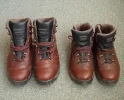Training is over rated 
As long as you are fairly fit and have done some regular walking to wear in your footwear you'll be fine.
As I was
very unfit and
overweight I started to ramp up my training 4 months out...........and as a result at 2 months out developed Achilles Tendonitis. Then wrecked my back 4 weeks out. Another story.
I was only able to actually walk (with a limp) a week before I departed for my Camino. So I had not trained for 2 months. I hadn't even walked more than 200 metres for 2 months...... Let alone carry a back pack. Throwing on my pack leaving Sydney was a shock and my tendons sure let me know!
I arrived in St Jean.........unfit and over weight.
But I made it. in 40 days. A bit fitter by the end, but not much lighter (wine and food). And still with a limp.
All my great 'virtual friends' here told me not to worry, but use the first few days on the Camino for training.
Which I did. Only 8 kms day 1. It was day 4 before I got up to 20 kms. A couple of weeks later I was doing 30 kms. (But that proved too far for my screwed up legs/feet) 20-22 / day was my sweet spot.
My point?
Don't stress over training. I met people who were probably 20 KG overweight. And they made it. (I was 10 over).
I met people aged 75 that I could not keep up with.
I met people with hip problems.
I met people with disabilities.
I met a guy with a wooden leg!
Guess what..........they all made it...........
To me the Camino is all about attitude and mental strength..... If you really want to get there, you will.
OK, OK..... being fitter and not so overweight will make it a bit easier

Just make sure your footwear is good, worn in and take all the advice about avoiding and treating blisters. Anything else, you can easily deal with.
After thought..... What type of training can you realistically do for the Camino? What will prepare you for the day after day pounding that your lower body and back takes?
I would suggest general fitness/cardio training. Leg and joint strengthening. What do others think?
I was surprised how my body deteriorated the further I walked. I managed 14 days before my first day off. (Burgos) Then only about 7 days apart after that.
I think what caused my overall decline, in the sense that I had to shorten my daily distances, was over doing it midway.
Once I was comfortable with 20-22 kms I should have stayed with that. But accommodation options and over optimism pushed me to do 31 kms the day before arriving in Burgos. That caused some damage that I probably never really recovered from.
A couple of other long days really started shin pain on top of the Achilles pain. By the end I was down to 15 km days. Pushing 20 on the final 2 days.
My point? Monitor how your body is coping very closely......... Pushing too far too early can jeopardise your whole journey....
But there again........I'm a 58 YO overweight couch potato

Others seem to find it a breeze

























